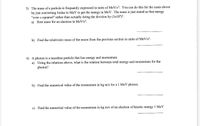Question
thumb_up100%
the mass of a particle is frequently expressed in units of MeV/c^2

Transcribed Image Text:3) The mass of a particle is frequently expressed in units of MeV/c?. You can do this for the cases above
by just converting Joules to MeV to get the energy in MeV. The mass is just stated as that energy
"over c-squared" rather than actually doing the division by (3x10*)².
a) Rest mass for an electron in MeV/c2.
b) Find the relativistic mass of the muon from the previous section in units of MeV/c².
4) A photon is a massless particle that has energy and momentum.
a) Using the relations above, what is the relation between total energy and momentum for the
photon?
b) Find the numerical value of the momentum in kg m/s for a 1 MeV photon.
c) Find the numerical value of the momentum in kg m/s of an electron of kinetic energy 1 MeV
Expert Solution
This question has been solved!
Explore an expertly crafted, step-by-step solution for a thorough understanding of key concepts.
This is a popular solution
Trending nowThis is a popular solution!
Step by stepSolved in 4 steps with 4 images

Knowledge Booster
Similar questions
- Consider an electron gyrating in the magnetic field associated with a sunspot which has a magnetic field strength of 0.25 T. The typical temperature of a sunspot is 3500 K the equipartition equation for velocity v, temperature T and mass m of a particle, is, 3kgT V = m kB is Boltzmann's constant (1.38×10–23 J/K). a) The mass of the Sun is approximately 2 × 1030 kg. Use this information and the infor- mation given above to compute the acceleration g due to gravity at the surface of the Sun. b) Compute the drift velocity Ūg due to gravity for a proton and an electron located within a sunspot. c) Assuming a typical mass density of the Sun's photosphere of 10-3 kg/m³, compute the number density of protons and electrons in the photosphere (where sunspots reside) assuming that the Sun is comprised of pure ionized hydrogen. d) Calculate the total current density J (accounting for the contributions of both electrons and tons) within sunspots. You may assume that you can treat the ensemble of…arrow_forwardHelpful information: (1) An alpha particle is a helium nucleus, (2) e = 1.6 × 10-¹⁹ C, (3) k = 9.0 × 10⁹ Nm² C-2, (4) 1nm = 1 × 10-⁹ m 1-An alpha particle lies on the x-axis, a distance of 1.0 nanometer from a proton (in this set-up, the alpha particle is at the origin while the proton is in the positive direction). Which of the following choices below represents the magnitude of the electric force on the alpha particle? (a) 2.3 × 10-10 N (b) 4.6 × 10-¹0 N (c) 2.3 × 10-19 N (d) 4.6 × 10-19 N eplacing the voltage sou the following inst choices below time != 1.00 37 instantaneous currentarrow_forwardIf massQ/mass A in AQ= 0.271 and mass Q/ mass A in AxQy = 0.362, what is the formula of AxQY?arrow_forward
- 4. Consider following the following the fusion nuclear reaction: n+p+p→;He. What happens to the different types of potential energies of this system as a result the reaction (i.e. the electrical potential energy and the strong nuclear potential energy)? The atomic mass of He is 3.016029 u. a. The electrical potential energy and the strong nuclear potential energy both increase. b. The electrical potential energy increases and the strong nuclear potential energy decreases. c. The electrical potential energy increases and the strong nuclear potential energy remains the same. d. The electrical potential energy decreases and the strong nuclear potential energy increases. e. The electrical potential energy and the strong nuclear potential energy both decrease.arrow_forwardA particle has γ=9,853. Calculate c-v in m/s.arrow_forward
arrow_back_ios
arrow_forward_ios